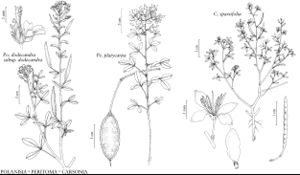Difference between revisions of "Cleomaceae"
FNA>Volume Importer |
imported>Volume Importer |
||
| (2 intermediate revisions by 2 users not shown) | |||
| Line 176: | Line 176: | ||
|publication year= | |publication year= | ||
|special status= | |special status= | ||
| − | |source xml=https:// | + | |source xml=https://bitbucket.org/aafc-mbb/fna-data-curation/src/2e0870ddd59836b60bcf96646a41e87ea5a5943a/coarse_grained_fna_xml/V7/V7_258.xml |
}}<!-- | }}<!-- | ||
-->[[Category:Treatment]] | -->[[Category:Treatment]] | ||
Latest revision as of 22:32, 5 November 2020
Herbs or shrubs, annual or perennial (usually deciduous, evergreen in Peritoma arborea); spines usually absent (present in Hemiscola and Tarenaya); glabrous or glandular-pubescent, hairs stalked or sessile (producing glucosinolates). Stems usually erect, sometimes spreading or procumbent; branched or unbranched. Leaves alternate, spirally arranged (usually palmately compound, sometimes simple); venation pinnate; stipules usually present (usually caducous, sometimes deciduous, 3–8-palmatifid, linear, threadlike, minute, scalelike, or absent, nodal (stipular) spines present in Tarenaya and Hemiscola); petiole present (pulvinus usually present, nectaries absent, petiolar spines sometimes present, petiolules present); blade margins entire, serrate, or serrulate. Inflorescences terminal or axillary, usually racemose, sometimes flat-topped, or flowers solitary (usually elongated in fruit); bud scales absent; bracts present or absent (unifoliate, often trifoliate proximally, bracteoles absent). Pedicels present. Flowers usually bisexual (developmentally unisexual within sections of racemes), actinomorphic or slightly zygomorphic, rotate to crateriform, campanulate, or urceolate; perianth and androecium hypogynous; sepals persistent or deciduous, 4, distinct or connate basally; petals 4, attached directly to receptacle, imbricate, distinct, equal or unequal; intrastaminal nectary-discs, scales, or glands present or absent; stamens [4–]6–27[–35]; filaments free or basally adnate to gynophore (or along proximal 1/3–1/2 in Gynandropsis) or androgynophore, glabrous or pubescent; anthers dehiscing by longitudinal slits, pollen shed in single grains, binucleate, commonly tricolporate; gynophore present or absent; pistil 1; ovary 1-carpellate (except 2 in Oxystylis), 2-locular; placentation parietal; ovules 1–18(–26+) per locule, anatropous, bitegmic; style 1 (straight, relatively short, thick, not spinelike in fruit, except in Oxystylis, sometimes in Wislizenia); stigma 1, capitate, unlobed. Fruits capsular or nutlets (usually stipitate from elongation of gynophore, erect to divergent, usually not inflated), valvate, elongate (± dehiscent by 2 lateral valves, except in Polanisia), or schizocarps (inflated in Peritoma arborea), indehiscent or dehiscent. Seeds 1–65[–200], tan, yellowish brown, light brown, pale green, brown, reddish brown, silver-gray, or gray to black (papillose or tuberculate); arillate or not; endosperm scanty or absent, persistent perisperm sometimes present; cotyledons incumbent, (radicle-hypocotyl elongated).
Distribution
Nearly worldwide, tropical and temperate regions.
Discussion
Genera 17, species ca. 150 (12 genera, 34 species in the flora).
A discussion of the status of Cleomaceae and its segregation from Capparaceae (in the narrow sense) appears under the latter. Throughout this treatment, style length indicates the length in fruit; in some species, the style elongates after anthesis. The key to genera, in some cases, include characteristics of species, in addition to those of genera. This circumscription of Cleomaceae includes Oxystylidaceae Hutchinson.
Selected References
Lower Taxa
Illustrations
Key
| 1 | Shrubs (evergreen); leaflets 3; fruits inflated or not. | Peritoma |
| 1 | Herbs; leaflets 1-9; fruits usually not inflated | > 2 |
| 2 | Inflorescences axillary, racemes (flat-topped); style spinelike in fruit. | Oxystylis |
| 2 | Inflorescences terminal or axillary (from distal leaves), racemes or corymbs, or flowers solitary; style not spinelike in fruit (except sometimes in Wislizenia) | > 3 |
| 3 | Stamens 8-32; gynophore usually 0-14 mm in fruit; fruits dehiscent in distal 1/2. | Polanisia |
| 3 | Stamens 6 (except Arivela with 14-25); gynophore usually 0.5-85 mm in fruit (in Arivela viscosa fruits sessile or absent); fruits dehiscent ± entire lengths or indehiscent | > 4 |
| 4 | Fruits schizocarps; seeds 2(-4), 0.5 mm. | Wislizenia |
| 4 | Fruits capsules; seeds 1-40, 1.2-3.5 mm | > 5 |
| 5 | Fruits 2-8 mm, as long as or shorter than wide. | Cleomella |
| 5 | Fruits (2-)12-150 mm, much longer than wide | > 6 |
| 6 | Plants with stipular spines (sometimes petioles with spines) | > 7 |
| 6 | Plants without stipular spines (petioles without spines) | > 8 |
| 7 | Petals 11-30(-45) mm; gynophore 45-80 mm in fruit. | Tarenaya |
| 7 | Petals 5-10 mm; gynophore 1-4 mm in fruit. | Hemiscola |
| 8 | Filaments adnate basally to gynophore (scars evident in fruiting specimens near midpoint of gynophore). | Gynandropsis |
| 8 | Filaments free from gynophore (or gynophore obsolete) or inserted on androgynophore | > 9 |
| 9 | Bracts 1-18 mm, unifoliate. | Cleoserrata |
| 9 | Bracts 1-25 mm, unifoliate or trifoliate (sometimes expanded) | > 10 |
| 10 | Gynophore obsolete; stems, leaflet surfaces, and fruitsglandular-hirsute. | Arivela |
| 10 | Gynophore 1-25 mm (in fruit); stems, leaflet surfaces, and fruits usually not glandular (sometimes pubescent) | > 11 |
| 11 | Sepals distinct; gynophore 2-5 mm in fruit; anthers 3-5 mm. | Carsonia |
| 11 | Sepals partly connate or distinct; gynophore 1-25 mm; anthers 0.6-2.6 mm | > 12 |
| 12 | Filaments inserted on cylindric androgynophore (usually expanded adaxially into gibbous or flattened appendage); leaflets conduplicate and flat. | Peritoma |
| 12 | Filaments inserted on discoid or conical androgynophore; leaflets flat. | Cleome |


